
05-12-2025 17:33
 Bruno Coué
Bruno Coué
Bonjour, je serais heureux de recueillir votre avi

07-12-2025 09:24
De la pasada semana en Galicia EspañaEn el suelo

06-12-2025 00:19
 Viktorie Halasu
Viktorie Halasu
Hello, would anyone have this article, please? An

02-12-2025 18:59
This pair of ascos 2.5cm across were on recently b

02-12-2025 19:25
Buckwheat PeteHello, can anyone identify this hairy fungus growi

30-11-2025 12:53
 Edvin Johannesen
Edvin Johannesen
White short-stipitate apothecia found on thin twig
Earlier today I found a minute discomycete growing on dying leaves of Galium saxatile on a grassy streambank in the Lake District, NW England. Details as follows:
Apothecia 80-200 µm diam; with a short stalk; grey to pale greenish-blue (dark greenish-blue at the base of the stalk).
Asci 30-40 x 5-7 µm; 8-spored; apex blue in Lugols.
Ascospores fusiform; hyaline; 0-septate; 9-11 x 2-2.5 µm; 2 large oil bodies.
Paraphyses sparse; narrowly cylindrical; about as long as asci.
Hairs more or less cylindrical or slightly tapering to rounded apex; <40-45 x 2-3 µm; verruculose.
Some images attached.
I rarely look at discomycetes and I'm struggling to put a name to this specimen. Possibly a Cistella? I'd be grateful for any help anyone can provide.
Thanks
Marcus

Thanks for replying.
Apothecia were 80-200 µm (mostly towards the lower end of the range) & were distinctly stalked. I don't think the ectal excipulum was gelatinised.
No macro images I'm afraid.
The specimen is indeed sparse but if I get the chance I'll revisit the site & try to find some more.
Marcus


What about Incrupila? -Then again, verrucose is not = thick crystalline crust on the hairs and hairs seem aseptate here as well. Green-blue colours certainly a rare character. Somewhere around Cistella or Hyphodiscus would be my guess (too). It doesnt look like a Hyaloscyphaceae (s str) or Lachnaceae (s lat), --kind of too fragile (?) for the latter.
Timo





The apothecia in my collection are very small and the turquoise colour isn't very well developed but in other respects it fits descriptions of Chlorocibora aeruginella.
Marcus
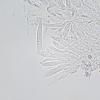
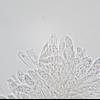
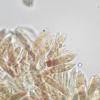
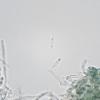
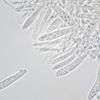
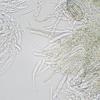
 Chlorociboria.-Boletus-2002-0002.pdf
Chlorociboria.-Boletus-2002-0002.pdf